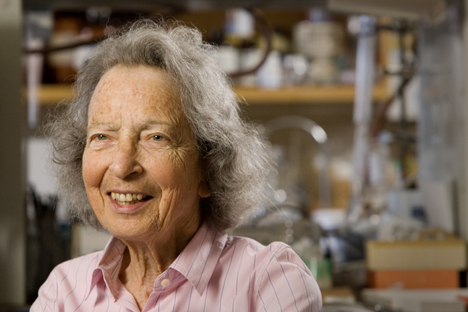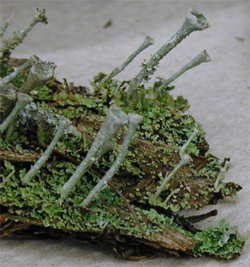
Thousands of people may notice the name Culberson each year as they step over the threshold into the Asiatic collection at Sarah P. Duke Gardens.
Far fewer are likely to notice the same name being added to the Lichen Herbarium and Library in a corner of the Biological Sciences building this week, but it's no less monumental.
The biology department is adding a modest plaque to the room to recognize the contributions of Chicita Culberson, who has devoted her career to the painstaking task of cataloguing the chemical diversity of lichens, those drab growths one sees clinging to life on rocks and tree trunks in the most unlikely places.
What she perfected, starting in the 1950s, was a way to sort out the secondary chemical compounds that lichens produce and make them into a permanent visual record, a fingerprint of sorts that easily distinguishes one species from another.
To the untrained eye, and even to many of the trained ones, lichens are sometimes hard to tell apart just by looking. It was Culberson, who earned a Ph.D. in chemistry at Duke under the legendary Pelham Wilder, who figured out a standardized way to chemically sort lichens so they could be identified.
It's called thin-film chromatography and it's fussy, detailed, eye-squinting work. She's still doing it full time and some weekends at age 78 in a chilly lab filled with functioning museum-piece equipment. "I don't know, I just like to mess around," she says with a shrug and one of her easy smiles.
"For lichenologists, this is the equivalent of when they were able to sequence DNA," says lichenologist François Lutzoni, associate professor of biology and curator of Duke's lichen collection. "Her work is so fundamental. She developed this standard protocol and people used it religiously. It's still as important as it was then."
Every lab working on lichen and every systematist trying to identify lichen species has relied on Culberson's technique for the last 50 years, Lutzoni says. He cannot begin to guess how many papers were built on it, nor the value it has had to pharmaceutical and chemical companies that are interested in lichen products, such as antifungals, sunscreens and antibiotics.

"Chicita's pioneering work and dedication brought lichen chemistry out of the dark ages," said lichenologist Doug Ladd, director of conservation science for the Nature Conservancy in St. Louis. "Having relatively simple methods to assess the chemical constituents of lichens opened up our understanding of lichen taxonomy, ecology, physiology, and biogeography in ways that are continuing to this day. Her work remains invaluable even with the advent of modern molecular techniques."
So soft-spoken Chicita and her authoritative chemical catalog of the lichens are giants in the field. But her work has really just been a hobby. She has her own lab, brought in some crucial grants, and is officially a senior research scientist in the biology department, but Duke has never paid her.
She came to Duke in 1955 with her husband William L. Culberson, who had been hired to teach general botany. "He was very, very bright and a very, very hard worker," she says. "And they had a horrible, horrible job."
The junior faculty post paid $4,000 a year. Chicita started in the chemistry Ph.D. program, where her tuition was the same, about $4,000 a year. "I did the housework and sewed the hems on the pants and puttered along on my Ph.D."
And as Bill rose through the ranks eventually to become chairman of botany and director of the Sarah P. Duke gardens, Chicita revolutionized their field.
"We came here with the idea that he would be the botanist and I would be the chemist and we could work together symbiotically," she says. It's a choice analogy: lichens themselves are actually two organisms -- fungus and algae -- working together in symbiosis. Bill died in 2003, but Chicita's still working.
An early adopter of computers, Chicita adapted the chromatography data to paper punchcards to digitize them and to standardize the field still more. Much of Duke's 160,000-specimen lichen collection has been cataloged this way and she continues to build an internationally used database.
It's all on the Internet now, but the punchcards are still there in a file drawer, should they ever be needed. The lichen specimens from Ohio, Wisconsin, Massachusetts and France that Bill brought along when he first arrived in Durham are still in the collection, too.
And daily e-mails and phone calls come in from all over the world seeking Chicita's advice. "Most of what I do now is trying to help people," she says.